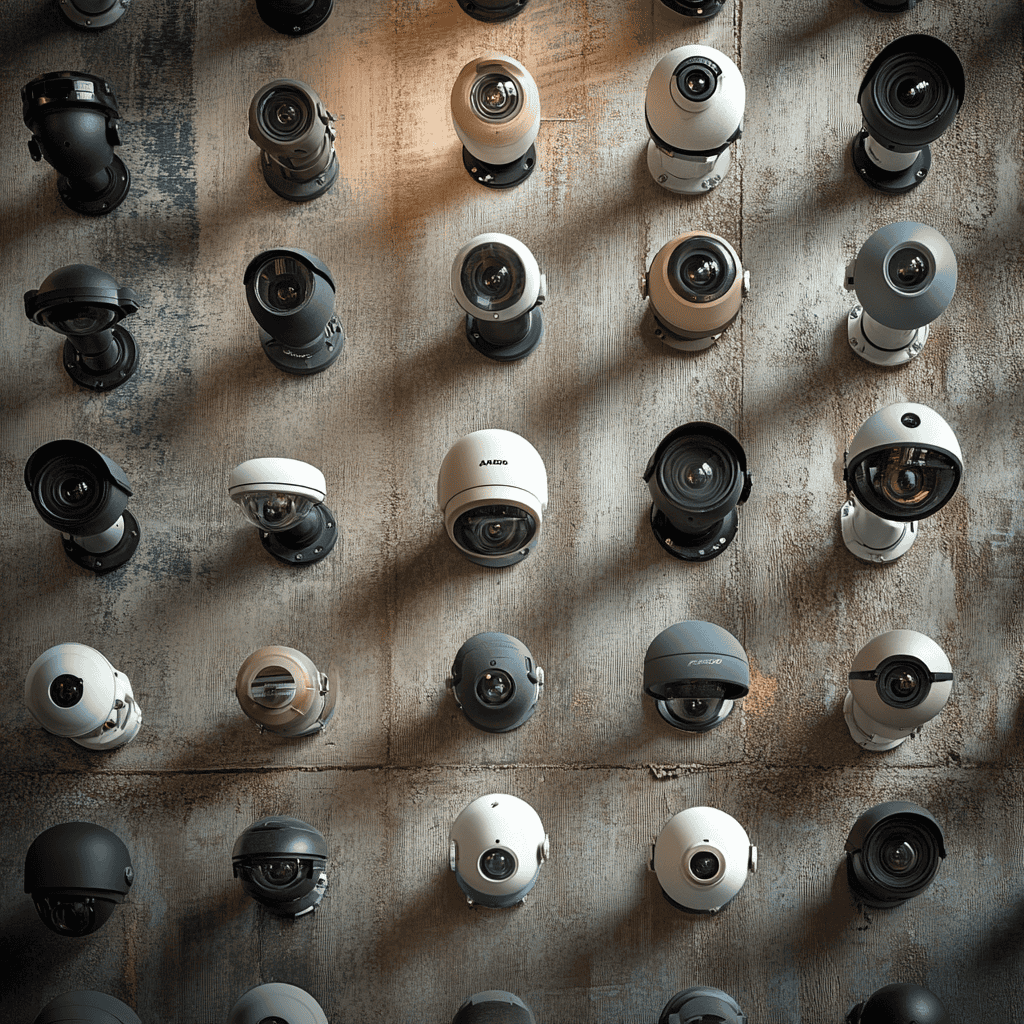Dummy security cameras are non-functional devices designed to mimic real surveillance cameras, acting as a cost-effective deterrent to potential intruders. They include realistic designs, faux lenses, and often feature blinking lights or simulated movement to enhance their authenticity. Installation is straightforward, typically involving basic tools and strategic placement in highly visible areas to maximize their deterrent effect. By creating the illusion of active surveillance, these cameras exploit psychological triggers in intruders, causing hesitation and fear of detection. Combining dummy cameras with real ones can create a thorough security illusion at a lower cost. Understanding these elements offers deeper insights into their effectiveness.
Key Takeaways
- Dummy cameras mimic real security cameras with realistic designs and visible components to create the illusion of active surveillance.
- Blinking LED lights and motion sensors enhance the appearance of functionality, simulating active recording and motion detection.
- Proper placement in high-visibility areas maximizes the deterrent effect by making potential intruders believe they are being watched.
- Visible wiring and authentic-looking elements, such as faux lenses, contribute to the overall realism of dummy cameras.
What Are Dummy Cameras?
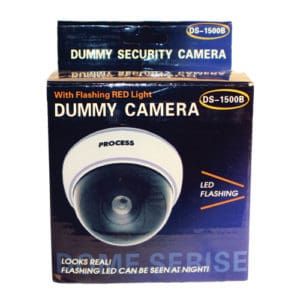 Dummy cameras are non-functional surveillance devices designed to mimic real security cameras. They’re an effective, low-cost deterrent to potential intruders who can’t easily distinguish them from operational cameras.
Dummy cameras are non-functional surveillance devices designed to mimic real security cameras. They’re an effective, low-cost deterrent to potential intruders who can’t easily distinguish them from operational cameras.
When choosing a dummy camera, you’ll encounter several types. Dome cameras are common and typically used indoors; they blend seamlessly with modern decor. Bullet cameras, often mounted outdoors, are more visible and suggest a higher level of security. Box cameras, which are larger and more conspicuous, can also be used to create the impression of a high-security environment.
When it comes to installation techniques, these devices are straightforward and versatile. You can mount a dummy camera on walls or ceilings using basic tools like screws and brackets. Positioning is key; place them in high-visibility areas to maximize their deterrent effect. Verify they mimic the placement of real surveillance systems for added authenticity.
Some dummy cameras even come with adjustable mounts, allowing you to angle them for ideal coverage. Remember to consider lighting and weather conditions for outdoor installations; placing them under eaves or other sheltered spots can enhance their longevity and maintain their realistic appearance.
Key Features of Dummy Cameras
Many dummy cameras are equipped with features that enhance their realism and effectiveness as deterrents. When choosing a dummy camera, you’ll find several key attributes that make it almost indistinguishable from real security cameras. These features can greatly boost the dummy camera’s benefits, making your property appear well-guarded.
First, many dummy cameras have a realistic design that closely mimics the appearance of functioning security cameras. This includes a similar size, shape, and material, guaranteeing they blend seamlessly with actual surveillance systems.
Second, some models feature motorized pan and tilt functions, which simulate the movement of live cameras, adding to their authenticity.
Finally, the presence of authentic-looking cables can strengthen the illusion that these cameras are real, deterring potential intruders.
- Realistic design and material
- Motorized pan and tilt functions
Placement is essential when considering installation. You’ll want to make sure that the dummy cameras are visible yet not easily accessible, which can maximize their deterrence effect.
It’s also worth considering the lighting conditions and mounting options to enhance the overall believability. Proper installation considerations can greatly amplify your property’s perceived security, leveraging the full range of dummy camera benefits.
Blinking Lights
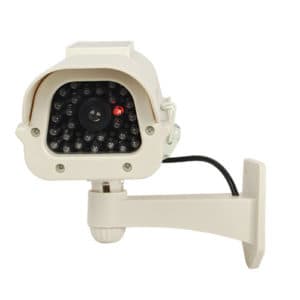 Another feature that greatly boosts the realism of dummy cameras is the inclusion of blinking lights. These lights are typically LED and are designed to emulate the behavior of a real security camera. The blinking patterns of these lights play a vital role in making the device appear genuine. By mimicking the LED effects of operational cameras, dummy cameras can effectively deter potential intruders.
Another feature that greatly boosts the realism of dummy cameras is the inclusion of blinking lights. These lights are typically LED and are designed to emulate the behavior of a real security camera. The blinking patterns of these lights play a vital role in making the device appear genuine. By mimicking the LED effects of operational cameras, dummy cameras can effectively deter potential intruders.
The LED lights on dummy cameras can be programmed to blink at various intervals, adding to the illusion of functionality. Here’s a breakdown of common blinking patterns and their effects:
| Blinking Pattern | LED Effects |
|---|---|
| Continuous Blinking | Simulates active recording |
| Intermittent Blinking | Gives the impression of motion-sensing |
| Random Blinking | Mimics advanced security features |
Continuous blinking suggests the camera is always recording, while intermittent blinking can imply the presence of motion sensors. Random blinking patterns can make the camera seem more sophisticated.
Motion Sensors
Motion sensors in dummy security cameras add an extra layer of deception by creating the illusion that the camera can detect and respond to movement. This feature relies on basic sensor technology to simulate motion detection. When someone walks by, the camera may swivel or a light might activate, giving the impression that the area is under vigilant surveillance.
Using motion sensors in dummy cameras can evoke a strong emotional response in potential intruders. Here are some reasons why:
- Sense of Urgency: The sudden activation of a light or camera movement can create a sense of immediate detection.
- Increased Anxiety: Knowing they might’ve triggered a camera can make individuals more nervous and likely to leave.
These sensors typically work by detecting changes in infrared radiation, which occurs when a warm object, like a person, moves in front of the camera.
The sensor technology in these dummy cameras is designed to mimic the functionality of real motion detection systems. Although these cameras don’t record or transmit data, the presence of motion sensors can greatly enhance their effectiveness as a deterrent.
Authentic-Looking Housings
To make dummy security cameras effective, you need housings that look just like real cameras.
By choosing designs that mimic actual surveillance equipment and incorporating visible wiring, you create an authentic appearance that can deter potential intruders.
Ensuring these elements are in place enhances the realism and effectiveness of your dummy camera setup.
Realistic Camera Design
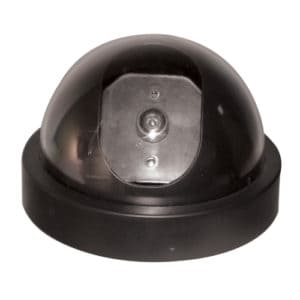 A realistic camera design with authentic-looking housings can greatly enhance the effectiveness of dummy security cameras. When the aesthetics of a dummy camera mirror the latest design trends in actual security equipment, they become much harder to distinguish from functional systems. This helps deter potential intruders who might otherwise recognize and dismiss a less convincing decoy.
A realistic camera design with authentic-looking housings can greatly enhance the effectiveness of dummy security cameras. When the aesthetics of a dummy camera mirror the latest design trends in actual security equipment, they become much harder to distinguish from functional systems. This helps deter potential intruders who might otherwise recognize and dismiss a less convincing decoy.
To achieve this realism, manufacturers often replicate the appearance of genuine cameras, focusing on:
- Detailed exteriors: High-quality materials and realistic finishes that mimic the look and feel of real security cameras.
- Modern design trends: Incorporating sleek, contemporary designs that align with current camera aesthetics used by professional security systems.
These elements play a significant role in fooling would-be intruders and providing a sense of security without needing costly functional cameras.
Visible Wiring Effects
Ever wondered how visible wiring can make dummy security cameras appear more authentic? The presence of visible wires can greatly enhance the realism of fake cameras. When potential intruders see wires running to and from the camera, they’re more likely to believe it’s functional.
To achieve this effect, proper wire management is essential. Make sure the wires are installed in a way that mimics real security setups. Use conduit pipes or cable trays to neatly route the wires along walls or ceilings. This not only makes the setup look realistic but also avoids creating a cluttered appearance.
Here are some installation tips to take into account:
First, choose appropriate wires for outdoor or indoor use, depending on where your dummy camera is placed. Outdoor wires should be weather-resistant.
Second, confirm that the wires are long enough to reach a logical power source or connection point, even if they’re not connected.
Third, use cable clips or brackets to secure the wires firmly; loose wires can give away the camera’s true nature.
Psychological Impact on Intruders
When intruders spot what they believe to be security cameras, they’re likely to reconsider their actions, creating deterrence through perception.
These fake cameras can cause increased anxiety levels, making potential criminals second-guess their decisions.
Deterrence Through Perception
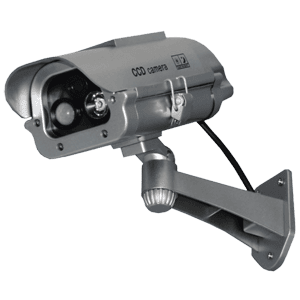 Dummy security cameras leverage the power of perception to make intruders think twice before attempting a break-in. By creating a strong perceived risk, these cameras can greatly elevate the fear factor in potential wrongdoers. When an intruder spots what appears to be a functional security camera, they’re likely to assume they’re being monitored and recorded, which can deter them from proceeding with their plans.
Dummy security cameras leverage the power of perception to make intruders think twice before attempting a break-in. By creating a strong perceived risk, these cameras can greatly elevate the fear factor in potential wrongdoers. When an intruder spots what appears to be a functional security camera, they’re likely to assume they’re being monitored and recorded, which can deter them from proceeding with their plans.
The psychological impact of dummy cameras hinges on several factors:
- Visual cues: Blinking lights, realistic housing, and strategic placement can all contribute to the perceived authenticity of the camera.
- Fear of consequences: The idea of getting caught on tape can make intruders reconsider their actions, as they fear legal repercussions.
Increased Anxiety Levels
Frequently, the mere sight of a security camera can heighten an intruder’s anxiety, making them second-guess their actions. When an intruder encounters what appears to be a surveillance device, several anxiety triggers come into play. These triggers can include the fear of being recorded, the possibility of law enforcement getting involved, and the potential for identification and subsequent consequences.
The psychological effects of these anxiety triggers can be significant. An intruder’s heightened anxiety levels can lead to increased stress and nervousness as they constantly worry about being watched and caught. This state of heightened alertness can cause physical symptoms such as sweating, rapid heartbeat, and trembling, making it more challenging for them to carry out their intended actions.
Moreover, this psychological pressure often results in an intruder feeling exposed and vulnerable. The constant awareness of a surveillance presence can create a mental barrier, increasing self-doubt and fear of detection. Consequently, these psychological effects can deter them from proceeding with their plans, as the perceived risk outweighs potential gains.
Decision-Making Hesitation
How does the presence of a dummy security camera cause intruders to hesitate in their decision-making? When an intruder spots what appears to be a security camera, their decision-making processes undergo significant scrutiny. The perceived presence of surveillance forces them to conduct a rapid risk assessment, weighing the potential consequences of their actions.
Here’s why decision-making hesitation occurs:
- Fear of Detection: The intruder worries about being caught on camera, which could lead to identification and subsequent arrest.
- Uncertainty Factor: The inability to distinguish a dummy camera from a real one creates a mental block, making them second-guess their actions.
These factors collectively slow down the intruder’s decision-making processes, often leading to the abandonment of their initial plans.
Strategic Placement Tips
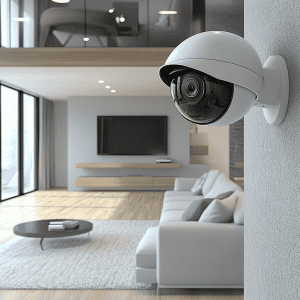 Placing dummy security cameras in high-visibility areas can effectively deter potential intruders. For outdoor placement, consider mounting cameras near entry points like front doors, garage doors, and gates. These spots are typically where intruders try to gain access, and having visible cameras there can make them think twice.
Placing dummy security cameras in high-visibility areas can effectively deter potential intruders. For outdoor placement, consider mounting cameras near entry points like front doors, garage doors, and gates. These spots are typically where intruders try to gain access, and having visible cameras there can make them think twice.
Additionally, positioning cameras at the corners of your property can provide a broader view and give the impression of thorough surveillance coverage.
Indoor placement is equally important. Inside your home, you can place dummy cameras in hallways, living rooms, or near windows that face the street. High-traffic areas are ideal because they suggest constant monitoring.
Make sure these cameras are at eye level or slightly above, where they can be easily seen by anyone entering the room.
Use realistic-looking dummy cameras with features like blinking lights or motion sensors to enhance their deterrent effect. Mount them securely and in a manner that mimics real security camera installations.
Proper placement can make a significant difference in convincing potential intruders that your property is well-protected, thereby reducing the likelihood of a break-in.
Combining With Real Cameras
To further enhance your property’s security, combine dummy cameras with real cameras for an effective layered defense. This strategy maximizes the deterrent effect while ensuring that actual surveillance captures any suspicious activity. By cleverly integrating both types of cameras, you create multiple layers of security that work together seamlessly.
First, install your real cameras in high-risk areas where they can capture critical footage. These should be positioned to cover main entry points and vulnerable spots around your property. Next, dummy cameras should be placed in visible locations to create the illusion of a thorough surveillance system. This combination confuses potential intruders, making it harder for them to discern which cameras are real.
Consider these points to evoke a sense of security and peace of mind:
- Increased deterrence: Intruders are less likely to target a property with visible cameras.
- Cost-effective coverage: Combining dummy and real cameras can save money while maintaining high security.
This integration of real cameras into your surveillance strategies strengthens your property’s security by leveraging the strengths of both dummy and real cameras. It’s a practical approach that creates a formidable deterrent against potential threats.
Cost-Effectiveness and Benefits
 In addition to boosting security, integrating dummy cameras with real ones is a cost-effective strategy that offers substantial benefits. By doing so, you can achieve significant cost savings without compromising the perceived security of your property. Dummy cameras are much cheaper than real cameras, allowing you to cover more ground within a limited budget. This approach maximizes the overall effectiveness of your security system while staying within budget considerations.
In addition to boosting security, integrating dummy cameras with real ones is a cost-effective strategy that offers substantial benefits. By doing so, you can achieve significant cost savings without compromising the perceived security of your property. Dummy cameras are much cheaper than real cameras, allowing you to cover more ground within a limited budget. This approach maximizes the overall effectiveness of your security system while staying within budget considerations.
When planning your security setup, it’s essential to allocate resources wisely. Investing in a few high-quality real cameras and supplementing them with strategically placed dummy cameras can deter potential intruders. The sight of multiple cameras, both real and fake, creates an illusion of thorough surveillance, leading would-be criminals to think twice before targeting your property.
Moreover, maintenance costs for dummy cameras are minimal. Since they don’t have electronic components, you won’t need to worry about repairs or software updates, which further adds to the cost savings.
Dummy cameras also offer flexibility; you can easily reposition them to adapt to changing security needs, ensuring continued effectiveness without additional expenses. Combining dummy and real cameras is a smart, budget-friendly way to enhance your security system.


